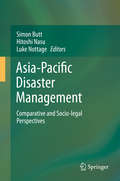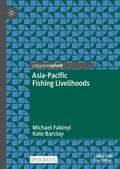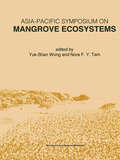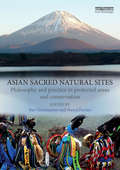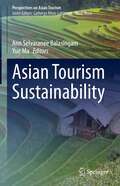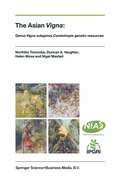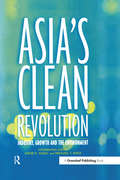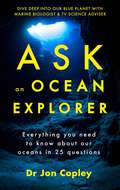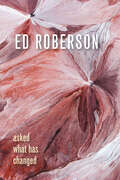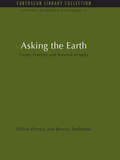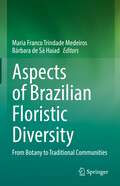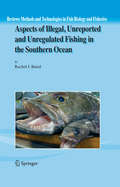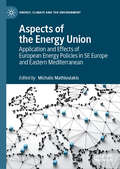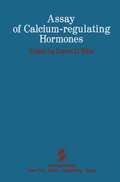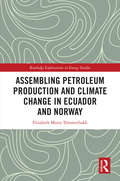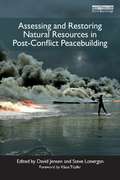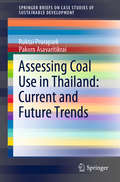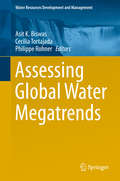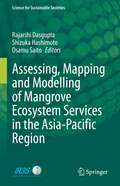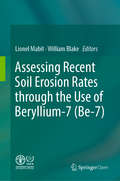- Table View
- List View
Asia-Pacific Disaster Management: Comparative and Socio-legal Perspectives
by Simon Butt Hitoshi Nasu Luke NottageThe book outlines the regulatory environment for disaster prevention and management in broad social, economic and political context. The first half of the book focuses mainly on Japan, especially the ‘3-11’ events: the earthquake and tsunami that devastated the Tohoku area on 11 March 2011 and the Fukushima Daiichi nuclear power plant radiation leaks. The second half focuses on the USA (the only other Asia-Pacific country to have experienced a serious nuclear emergency), Indonesia, China, New Zealand, Australia and international law. One question explored is whether socio-legal norms play different roles in preventing and managing responses to natural disasters compared to ‘man-made’ disasters. Another is how ‘disaster law’ interacts with society across very diverse societies in the disaster-prone Asia-Pacific region. The book also addresses the increasingly important roles played by international law and regional regimes for cross-border cooperation in disaster prevention and relief, including the functions played by military forces.Erudite, pragmatic, and charged with detailed, substantive knowledge of an astonishing range of contexts and research fields, this timely collection of important essays on the law and society of disaster management stands as an exemplary international academic response to the disasters of 11 March 2011. (Annelise Riles)
Asia-Pacific Fishing Livelihoods
by Michael Fabinyi Kate BarclayThis open access book explores fishing livelihoods in the context of the wider contexts in which they are embedded. Drawing on case studies from across the Asia-Pacific region, the book highlights how fishing livelihoods are shaped by globalisation, social relationships and governance. The book concludes by showing how better understanding these relationships can contribute to governance for healthier ecosystems and social wellbeing.This is an open access book.This is an open access book.
Asia-Pacific Symposium on Mangrove Ecosystems: Proceedings of the International Conference held at The Hong Kong University of Science & Technology, September 1–3, 1993 (Developments in Hydrobiology #106)
by Yuk-Shan Yuk-Shan Wong Nora F. Y. TamMangrove ecosystems are typical formations found in coastal deposits of mud and silt throughout the tropics and some distance into the subtropical latitudes. The total wordwide mangrove area, which is estimated at about 170,000 km2 with some sixty species of trees and shrubs exclusive to the habitat, dominates approximately 75% of the world's coastline between latitudes 25°N and 25°S. Such unique intertidal ecosystems support genetically diverse communities of terrestrial and aquatic organisms that are of direct or indirect socioeconomic values. Mangrove forests play important roles as coastal stabilization and protection against winds and storms; producers of nutrients, forest resources and animal species of economic importance. Recently, the issues on the conservation, proper utilization and management of mangrove forests have been widely discussed. Unfortunately, overexploitation and destruction of mangroves seriously threatens the sustainability of such a unique ecosystem. This volume includes papers on three main areas: recent advances in mangrove ecology; application and utilization of mangrove resources; and conservation and management of the ecosystems.
Asian Sacred Natural Sites: Philosophy and practice in protected areas and conservation
by Bas Verschuuren Naoya FurutaNature conservation planning tends to be driven by models based on Western norms and science, but these may not represent the cultural, philosophical and religious contexts of much of Asia. This book provides a new perspective on the topic of sacred natural sites and cultural heritage by linking Asian cultures, religions and worldviews with contemporary conservation practices and approaches. The chapters focus on the modern significance of sacred natural sites in Asian protected areas with reference, where appropriate, to an Asian philosophy of protected areas. Drawn from over 20 different countries, the book covers examples of sacred natural sites from all of IUCN’s protected area categories and governance types. The authors demonstrate the challenges faced to maintain culture and support spiritual and religious governance and management structures in the face of strong modernisation across Asia. The book shows how sacred natural sites contribute to defining new, more sustainable and more equitable forms of protected areas and conservation that reflect the worldviews and beliefs of their respective cultures and religions. The book contributes to a paradigm-shift in conservation and protected areas as it advocates for greater recognition of culture and spirituality through the adoption of biocultural conservation approaches.
Asian Sacred Natural Sites: Philosophy and practice in protected areas and conservation
by Bas Verschuuren Naoya FurutaNature conservation planning tends to be driven by models based on Western norms and science, but these may not represent the cultural, philosophical and religious contexts of much of Asia. This book provides a new perspective on the topic of sacred natural sites and cultural heritage by linking Asian cultures, religions and worldviews with contemporary conservation practices and approaches. The chapters focus on the modern significance of sacred natural sites in Asian protected areas with reference, where appropriate, to an Asian philosophy of protected areas. Drawn from over 20 different countries, the book covers examples of sacred natural sites from all of IUCN’s protected area categories and governance types. The authors demonstrate the challenges faced to maintain culture and support spiritual and religious governance and management structures in the face of strong modernisation across Asia. The book shows how sacred natural sites contribute to defining new, more sustainable and more equitable forms of protected areas and conservation that reflect the worldviews and beliefs of their respective cultures and religions. The book contributes to a paradigm-shift in conservation and protected areas as it advocates for greater recognition of culture and spirituality through the adoption of biocultural conservation approaches.
Asian Tourism Sustainability (Perspectives on Asian Tourism)
by Ann Selvaranee Balasingam Yue MaThis book brings together a collection of chapters that investigate sustainable tourism development in different Asian contexts; from stakeholders’ perspectives, existing issues in the market, as well as the impacts of COVID-19 on tourism. It highlights the importance of tourism sustainability in Asia. Specifically, this book examines these themes by examples related to Asian tourism such as; social-cultural impact of sustainable growth, environmental constraints and policies, community engagement, moral limits of the market, stakeholders’ participation in tourism development, the hindered interaction between foreign tourists and local community, impact of the pandemic and proposed ways forward. This edited volume substantiates this by using evidence of quantitative, qualitative and mixed methods approaches aligned with empirical data to show sustainable efforts and impacts. This book is of interest to researchers and practitioners as it offers timely understandings of sustainable tourism from multiple perspectives within the Asian context.
The Asian Vigna: Genus Vigna subgenus Ceratotropis genetic resources
by Norihiko Tomooka D. Vaughan Helen Moss Nigel MaxtedThe Asian beans and grams, the species of Vigna (subgenus Ceratotropis), include several legumes that are an essential component in the diets of a large proportion of Asia's population, and interest in these legumes is growing as ethnic cuisine spreads worldwide. However, this important group of legumes is little known compared to the closely related Phaseolus beans and soybean. That deficiency is addressed for the first time in this fully illustrated comprehensive conservation, genetics, taxonomic, and agricultural monograph on the genetic resources of the Asian Vigna. The book deals with the phylogeny of the group from the perspectives of morphological and molecular analyses, ex situ and in situ conservation, eco-geographical analyses, and research. In addition, morphological descriptions, keys, and eco-geographic details of each species in the group are provided. This genetic resources handbook and guide to the Asian Vigna will be a valuable reference for agriculturists, conservationists, taxonomists, other scientists, and students interested in the legumes and plant genetic resources.
Asia's Clean Revolution: Industry, Growth and the Environment
by David Angel Michal RockThe world's environmental future will be determined in significant part by what happens in the rapidly industrialising and urban economies of Asia. The sheer scale of urban population and industrial growth in Asia - from Indonesia to China - and the energy and materials intensive character of the development process constitutes a dark shadow over the region's, and indeed the world's, environment. And yet this challenge is also an opportunity. Precisely because so much of the urban-industrial investment within developing Asia has yet to take place, the opportunity exists to shape a different development future - one that is far less energy, materials and waste intensive.Asia's Clean Revolution examines the prospects for and pathways to such a new trajectory. The book lays out a path-breaking vision of how developing economies might go beyond environmental regulation and put in place an array of policies and institutions that could integrate environmental, industrial and technological goals. These findings provide important input for negotiators considering climate change on a global scale.The book approaches the challenge of growth and environment in Asia in a novel way, by identifying six major transformational dynamics under way in the world today, and assessing whether these can be harnessed to the goal of improved environmental performance of industry.With a set of specially commissioned chapters from the leading authorities in North America and Asia, this ground-breaking book is the first to present concrete policy solutions to the looming crisis driven by large-scale urban-industrial growth in developing Asia.
Asia's Clean Revolution: Industry, Growth and the Environment
by David Angel Michal RockThe world's environmental future will be determined in significant part by what happens in the rapidly industrialising and urban economies of Asia. The sheer scale of urban population and industrial growth in Asia - from Indonesia to China - and the energy and materials intensive character of the development process constitutes a dark shadow over the region's, and indeed the world's, environment. And yet this challenge is also an opportunity. Precisely because so much of the urban-industrial investment within developing Asia has yet to take place, the opportunity exists to shape a different development future - one that is far less energy, materials and waste intensive.Asia's Clean Revolution examines the prospects for and pathways to such a new trajectory. The book lays out a path-breaking vision of how developing economies might go beyond environmental regulation and put in place an array of policies and institutions that could integrate environmental, industrial and technological goals. These findings provide important input for negotiators considering climate change on a global scale.The book approaches the challenge of growth and environment in Asia in a novel way, by identifying six major transformational dynamics under way in the world today, and assessing whether these can be harnessed to the goal of improved environmental performance of industry.With a set of specially commissioned chapters from the leading authorities in North America and Asia, this ground-breaking book is the first to present concrete policy solutions to the looming crisis driven by large-scale urban-industrial growth in developing Asia.
Ask an Ocean Explorer
by Dr Jonathan Copley'Deftly conjures the wonders of a bathynaut's world' - Nature'An engaging book sprinkled with mind-blowing facts about the deep ocean' - Daily ExpressIt is often said that we know more about space than we do our own oceans, but is that really the case? Or do we in fact know a great deal more about the oceans than many people realise.The wellbeing of our oceans and the life contained within and around them has never been more important. But to truly understand the vital role they play, we need to first understand how the oceans work, how we explore them and learn about the mysteries they hold, and what our effect is on them.Between these pages is everything you need to know about our oceans, explained in 25 questions. Combining untold history of ocean exploration and personal account of what it's like to be a 'bathynaut' diving in a mini-submarine, Ask an Ocean Explorer brings to light weird and wonderful deep-sea creatures and how the oceans and their future is connected to our everyday lives.
Asked What Has Changed (Wesleyan Poetry Series)
by Ed RobersonAward-winning poet Ed Roberson confronts the realities of an era in which the fate of humanity and the very survival of our planet are uncertain. Departing from the traditional nature poem, Roberson's work reclaims a much older tradition, drawing into poetry's orbit what the physical and human sciences reveal about the state of a changing world. These poems test how far the lyric can go as an answer to our crisis, even calling into question poetic form itself. Reflections on the natural world and moments of personal interiority are interwoven with images of urbanscapes, environmental crises, and political instabilities. These poems speak life and truth to modernity in all its complexity. Throughout, Roberson takes up the ancient spiritual concern—the ephemerality of life—and gives us a new language to process the feeling of living in a century on the brink.Morello's Venice startled to hear the doctor saythis would be the last time he would see it,a person used to keeping things alivetalking terminus — even more startled when he returnedto hear him say it wasn't therethere were terrible rainsbookings cancelled. when late he arrived,everything was gone.his wife had a cold. they bundled together in blankets.he refilled my prescription torestore my soul.
Asking the Earth: Farms, Forestry and Survival in India (Natural Resource Management Set)
by Winin Pereira Jeremy SeabrookThe need to produce food without the destructive chemical horrors of much modern farming, for an intelligent use of dwindling natural resources and for humane forms of production is universal, the practice is limited. This book is an account of one, large, instance of success in practice. Twenty-five years ago, Winin Pereira, a nuclear physicist abandoned academia to start a co-operative farm at Alonde in a tribal area north of Bombay. The group experienced, and finally discarded, all the false hopes and promises of Western originated forms of development: ploughs that ploughed too deep, irrigation systems that lowered water tables, fertilizers and pesticides which managed the earth and became so expensive that poorer farmers were dispossessed. Instead they learnt from the adivasai, or tribal people, who have nurtured or been nurtured by foresets for millennia, ways of applying popular knowledge to contemporary problems. This book is a combination of Pereira's record of achievement of sustainable livelihoods and an account of the farm and its effect on the India around it by a leading British journalist. Originally published in 1991
Asking the Earth: Farms, Forestry and Survival in India (Natural Resource Management Set)
by Winin Pereira Jeremy SeabrookThe need to produce food without the destructive chemical horrors of much modern farming, for an intelligent use of dwindling natural resources and for humane forms of production is universal, the practice is limited. This book is an account of one, large, instance of success in practice. Twenty-five years ago, Winin Pereira, a nuclear physicist abandoned academia to start a co-operative farm at Alonde in a tribal area north of Bombay. The group experienced, and finally discarded, all the false hopes and promises of Western originated forms of development: ploughs that ploughed too deep, irrigation systems that lowered water tables, fertilizers and pesticides which managed the earth and became so expensive that poorer farmers were dispossessed. Instead they learnt from the adivasai, or tribal people, who have nurtured or been nurtured by foresets for millennia, ways of applying popular knowledge to contemporary problems. This book is a combination of Pereira's record of achievement of sustainable livelihoods and an account of the farm and its effect on the India around it by a leading British journalist. Originally published in 1991
Aspects of Brazilian Floristic Diversity: From Botany to Traditional Communities
by Maria Franco Trindade Medeiros Bárbara de Sá HaiadAspects of Brazilian Floristic Diversity: From Botany to Traditional Communities offers a unique approach in floristic diversity of the Neotropical region, specifically encompassing the Brazilian flora. This volume combines both theoretical and applied aspects of scientific making knowledge in different perspectives of Botanical Science. In this volume, botanical specialists discuss the many different approaches of taxonomic, reproductive, ecological and ethnobotanical aspects of Brazilian floristic diversity, thereby enlightening the global interest in Neotropical species, in particular those from the Brazilian territory. The book addresses relevant questions from many points of view, including anatomy, reproduction, palinology, conservation and ethnobotany, creating an in-depth perception of the flora in its complexity constitution.The book provides a comprehensive outlook on Botany Sciences, considering the history and traditional knowledge of plants, and relating it to contemporary problems and concerns of flora conservation today. With this current perspective, this book reaches a vast audience from the research lines of Botany, and encompasses a broader and interdisciplinary understanding of Aspects of Brazilian Floristic Diversity.
Aspects of Illegal, Unreported and Unregulated Fishing in the Southern Ocean (Reviews: Methods and Technologies in Fish Biology and Fisheries #5)
by Rachel BairdIllegal, Unreported and Unregulated (IUU) fishing threatens the viability of high seas living resources. This book details the efforts of the Convention for the Conservation of Antarctic Marine Living Resources Commission and the Australian government to adopt complementary measures to deter IUU fishing in the Southern Ocean. It describes how these various measures have proven effective in deterring IUU operators.
Aspects of the Energy Union: Application and Effects of European Energy Policies in SE Europe and Eastern Mediterranean (Energy, Climate and the Environment)
by Michalis MathioulakisThis book provides a comprehensive exploration of some of the most critical issues regarding the EU’s Energy Union policy. Applied European energy policies face a number of challenges ranging from the geopolitics of energy and energy regulation, to climate change, advancing renewable and gas technologies, and consumer empowerment structures. This book takes a multi-dimensional look into some of these vital issues regarding the European energy sector with a special focus on the effects the Energy Union policy has in two sensitive regional systems, Southeastern Europe and the Eastern Mediterranean.Energy, being by definition a multi-disciplinary field, presents a challenge for readers of any specific disciplinary background that need to grasp an overall understanding of the various aspects of this exciting sector. This book’s objective is to offer the opportunity for readers to get a quality, hands-on overview of the Energy Union by the professionals and academics that interact with it on a daily basis.
Assay of Calcium-regulating Hormones
by Daniel D. BikleThe ability to measure accurately the hormones regulating calcium homeosta sis is the fundamental first step toward understanding the roles these hormones play in health and disease. Techniques for such measurements have only been available for the past 10 years or so and remain in a state of rapid development. Sensitive parathyroid hormone (PTH) radioimmunoassays appeared in the early 1970s, and with them came a whole new appreciation for the prevalence and implications of hyperparathyroidism, primary or secondary, in the popu lation. The calcitonin (CT) radioimmunoassay came later and achieved rapid success in the. diagnosis of a previously poorly understood cancer, medullary carcinoma of the thyroid, frequently associated with the familial multiple endo crine neoplasia type 2 syndromes (a and b). As the sensitivity of the calcitonin radioimmunoassay has improved, our understanding of the role of calcitonin in normal physiological processes has increased. The knowledge that vitamin D must be metabolized to produce its biologic effects is only 15 years old. This has had profound implications in our understanding of a variety of metabolic bone, kidney, and gastrointestinal diseases. Assays to measure the major cir culating form of vitamin D, 25-hydroxyvitamin D, were described 10 years ago. Assays for the other metabolites, in particular, 1,25-dihydroxyvitamin D, were described even more recently. As of today, we know of many vitamin D metabolites and have developed the techniques to measure most of them; how ever, many questions remain concerning their physiological role.
Assembling Petroleum Production and Climate Change in Ecuador and Norway (Routledge Explorations in Energy Studies)
by Elisabeth Marta TómmerbakkThis book addresses some of the controversies and uncertainties associated with reducing the extensive exploitation of fossil fuels due to their role in global warming. Elisabeth Marta Tómmerbakk explores why a transition towards a post-carbon society is so difficult to accomplish by examining how the relationship between petroleum production and climate change is politically framed and negotiated in contested cases. This question is approached through a process-oriented comparative case study of Lofoten, located in the Norwegian Sea above the Arctic Circle, and Yasuní-ITT (Ishpingo, Tambococha, and Tiputini) located in the Ecuadorian Amazon: regions that both belong to oil-exporting countries with highly oil-dependent economies. Tómmerbakk draws on rich empirical data that includes qualitative interviews with subjects in both countries and applies an Actor-Network Theory framework to show that oil and climate are intricately entangled in knowledge and policy practices. Overall, Assembling Petroleum Production and Climate Change in Ecuador and Norway provides an in-depth examination of how climate science and petroleum extraction are negotiated, adapted, assembled, and coordinated with other national policies and political aims. This book will be of great interest to students and scholars of petroleum production, climate change, environmental policy, and environmental sociology.
Assembling Petroleum Production and Climate Change in Ecuador and Norway (Routledge Explorations in Energy Studies)
by Elisabeth Marta TómmerbakkThis book addresses some of the controversies and uncertainties associated with reducing the extensive exploitation of fossil fuels due to their role in global warming. Elisabeth Marta Tómmerbakk explores why a transition towards a post-carbon society is so difficult to accomplish by examining how the relationship between petroleum production and climate change is politically framed and negotiated in contested cases. This question is approached through a process-oriented comparative case study of Lofoten, located in the Norwegian Sea above the Arctic Circle, and Yasuní-ITT (Ishpingo, Tambococha, and Tiputini) located in the Ecuadorian Amazon: regions that both belong to oil-exporting countries with highly oil-dependent economies. Tómmerbakk draws on rich empirical data that includes qualitative interviews with subjects in both countries and applies an Actor-Network Theory framework to show that oil and climate are intricately entangled in knowledge and policy practices. Overall, Assembling Petroleum Production and Climate Change in Ecuador and Norway provides an in-depth examination of how climate science and petroleum extraction are negotiated, adapted, assembled, and coordinated with other national policies and political aims. This book will be of great interest to students and scholars of petroleum production, climate change, environmental policy, and environmental sociology.
Assessing and Restoring Natural Resources In Post-Conflict Peacebuilding (Post-Conflict Peacebuilding and Natural Resource Management)
by David Jensen Stephen LonerganWhen a country emerges from violent conflict, the management of the environment and natural resources has important implications for short-term peacebuilding and long-term stability, particularly if natural resources were a factor in the conflict, play a major role in the national economy, or broadly support livelihoods. Only recently, however, have the assessment, harnessing, and restoration of the natural resource base become essential components of postconflict peacebuilding. This book, by thirty-five authors, examines the experiences of more than twenty countries and territories in assessing post-conflict environmental damage and natural resource degradation and their implications for human health, livelihoods, and security. The book also illustrates how an understanding of both the risks and opportunities associated with natural resources can help decision makers manage natural resources in ways that create jobs, sustain livelihoods, and contribute to economic recovery and reconciliation, without creating new grievances or significant environmental degradation. Finally, the book offers lessons from the remediation of environmental hot spots, restoration of damaged ecosystems, and reconstruction of the environmental services and infrastructure necessary for a sustainable peace. Assessing and Restoring Natural Resources in Post-Conflict Peacebuilding is part of a global initiative to identify and analyze lessons in post-conflict peacebuilding and natural resource management. The project has generated six books of case studies and analyses, with contributions by practitioners, policy makers, and researchers. Other books address highvalue resources, land, water, livelihoods, and governance.
Assessing and Restoring Natural Resources In Post-Conflict Peacebuilding: Assessing And Restoring Natural Resources In Post-conflict Peacebuilding (Post-Conflict Peacebuilding and Natural Resource Management)
by David Jensen Steve LonerganWhen a country emerges from violent conflict, the management of the environment and natural resources has important implications for short-term peacebuilding and long-term stability, particularly if natural resources were a factor in the conflict, play a major role in the national economy, or broadly support livelihoods. Only recently, however, have the assessment, harnessing, and restoration of the natural resource base become essential components of postconflict peacebuilding. This book, by thirty-five authors, examines the experiences of more than twenty countries and territories in assessing post-conflict environmental damage and natural resource degradation and their implications for human health, livelihoods, and security. The book also illustrates how an understanding of both the risks and opportunities associated with natural resources can help decision makers manage natural resources in ways that create jobs, sustain livelihoods, and contribute to economic recovery and reconciliation, without creating new grievances or significant environmental degradation. Finally, the book offers lessons from the remediation of environmental hot spots, restoration of damaged ecosystems, and reconstruction of the environmental services and infrastructure necessary for a sustainable peace. Assessing and Restoring Natural Resources in Post-Conflict Peacebuilding is part of a global initiative to identify and analyze lessons in post-conflict peacebuilding and natural resource management. The project has generated six books of case studies and analyses, with contributions by practitioners, policy makers, and researchers. Other books address highvalue resources, land, water, livelihoods, and governance.
Assessing Coal Use in Thailand: Current and Future Trends (SpringerBriefs on Case Studies of Sustainable Development)
by Ruktai Prurapark Pakorn AsavaritikraiThis book highlights Thailand’s growing demand for clean energy from coal. The main source of energy for electricity production in Thailand (70%) is currently natural gas. However, natural gas extraction remains limited, resulting in an increasing need to import natural gas from other countries, which in turn leads to rising prices and unstable supplies. As such, coal energy is essential for industrial use and electricity production in Thailand. The book discusses the importance of developing and implementing clean technologies for coal. It also argues that collaborations between the government, private sector and the public are vital to achieving a mutual understanding and acceptance of coal energy and clean technologies, as well as a reduction in harmful emissions.
Assessing Global Water Megatrends (Water Resources Development and Management)
by Asit K. Biswas Cecilia Tortajada Philippe RohnerThis book highlights what are likely to be the future megatrends in the water sector and why and how they should be incorporated to improve water governance in the coming decades. In this first ever book on megatrends for the water sector, 22 leading world experts from different disciplines representing academia, business, government, national and international organisations discuss what the major megatrends of the future are and how they will radically change water governance in the coming decades.
Assessing, Mapping and Modelling of Mangrove Ecosystem Services in the Asia-Pacific Region (Science for Sustainable Societies)
by Rajarshi Dasgupta Shizuka Hashimoto Osamu SaitoThis book presents the state-of-the-art of knowledge in assessing, mapping, and modeling mangrove ecosystem services and outlines various scientific tools and techniques, including environmental scenario-building, spatial and econometric modelling to understand the fluctuations and future availability of mangrove ecosystem services. The book also highlights the current gaps and measures in policy planning and outlines the avenues for capacity building. Through case studies and thematic reviews, the book plans to cater to a wide range of audiences, including students, researchers, and decision-makers at various levels involved in mangrove conservation and land use optimization for sustainable and resilient development. This book is particularly useful to researchers and students in the field of landscape and spatial ecology, coastal zone management, ecosystem services, and resilience planning. It is also a must-read for policymakers, conservators, coastal zone managers, foresters, and general administrators in understanding the current and future roles of mangroves in ecosystem-based adaptation through informed decision-making.
Assessing Recent Soil Erosion Rates through the Use of Beryllium-7 (Be-7)
by Lionel Mabit William BlakeThis open access book is the first comprehensive guideline for the beryllium-7 (Be-7) technique that can be applied to evaluate short-term patterns and budgets of soil redistribution in agricultural landscapes. While covering the fundamental and basic concepts of the approach, this book distinguishes itself from other publications by offering step-by-step instructions on how to use this isotopic technique effectively. It covers experimental design considerations and clear instruction is given on data processing. As accurate laboratory measurement is crucial to ensure successful use of Be-7 to investigate soil erosion, a full chapter is devoted to its specific determination by gamma spectrometry. This open access contribution further describes new developments in the Be-7 technique and includes a concluding chapter highlighting its potential benefits to support the implementation of area-wide soil conservation policy.
